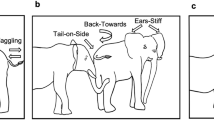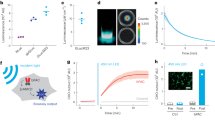Abstract
ANIMAL luminescence comprises two broad categories, namely, those in which light is produced by the animal, and those in which it is due to symbiotic bacteria; but in either event it may be under the control of the animal. The emission of light would then be a significant indication of the progress of underlying physiological events, and by quantitative recording should provide information about the physiology of luminescent effectors. Considerations of this kind have prompted a study of the physiology of light production in the polychæte Chœtopterus variopedatus. This is a well-known luminescent worm about 10 cm. long that discharges a luminescent secretion from definite circumscribed glands in certain regions of the body1. The glandular cells responsible are elongated eosinophilic elements packed with a paraplasmic mass of secretory granules, and when animals are excited and killed simultaneously by dropping into a fixative, the photogenic cells are caught in the act of secreting, and have the appearance of squeezing forth their contents2.
This is a preview of subscription content, access via your institution
Access options
Subscribe to this journal
Receive 51 print issues and online access
$199.00 per year
only $3.90 per issue
Buy this article
- Purchase on Springer Link
- Instant access to full article PDF
Prices may be subject to local taxes which are calculated during checkout
Similar content being viewed by others
References
Bonhomme, C., Bull. Inst. Océanogr. Monaco, No. 843 (1943). Krekel, A., Z. wiss. Zool., 118, 480 (1920). Panceri, P., Atti R. Accad. Napoli, 7, No. 1 (1878). Trojan, E., Sitz. Bench. Akad. Wiss Wien, 122, 565 (1913).
Nicol, J. A. C., J. Mar. Biol. Assoc., [30, 417 (1952)].
Nicol, J. A. C., J. Mar. Biol. Assoc., [30, 433 (1952)].
Chase, A. M., Biol. Bull., 81, 296 (1941).
Greene, C. W., and Greene, H. H., Amer. J. Physiol., 70, 500 (1924).
Nicol, J. A. C., Physiol. Comp. Oecol. (in the press).
Author information
Authors and Affiliations
Rights and permissions
About this article
Cite this article
NICOL, J. Luminescent Responses in Chætopterus and the Effects of Eserine. Nature 169, 665–666 (1952). https://doi.org/10.1038/169665b0
Issue Date:
DOI: https://doi.org/10.1038/169665b0
Comments
By submitting a comment you agree to abide by our Terms and Community Guidelines. If you find something abusive or that does not comply with our terms or guidelines please flag it as inappropriate.



